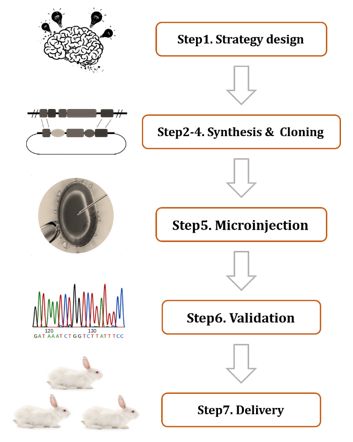
Our promise to you:
Guaranteed product quality, expert customer support.
 24x7 CUSTOMER SERVICE
24x7 CUSTOMER SERVICE
 CONTACT US TO ORDER
CONTACT US TO ORDER
Custom Rabbit Model 
Rabbits are one of the most commonly used experimental animals for biomedical research, especially as bioreactors that produce antibodies. However, recent studies have shown that many unique features of rabbit make it an excellent species for examining human diseases such as atherosclerosis, and maybe the preferred model for translational medical research.
CRISPR/Cas9 PlatformCB has partnered with leading researchers in the fields of neuroscience, cancers, cardiovascular, infectious diseases and immunology, and developments a range of innovative CRISPR/Cas9 gene-editing rabbit models for studying human diseases. Our rabbit models are dedicated to solving drug discoveries and advance the disease research exponentially.
Our customized CRISPR/Cas9 rabbit models include
- Constitutive knockout model
- Point mutation rabbit model
- Conditional knockout/knockin
- Floxed allele insertion
- Fluorescent tag insertion (GFP, RFP, mCherry, etc.) or immunotags insertion (e.g. Flag, HA, etc.)
Workflow of our CRISPR/Cas9 rabbit model service

- Strategy design
- Select guide RNA target sites and synthesize gRNA.
- Design and synthesize donor DNA (if needed).
- CRISPR vector construction.
- Plasmid microinjection by our skilled injection specialist (we will inject as many embryos as needed to fulfill the guarantee).
- Screening and identification (via PCR and sequencing).
- Deliver the final rabbit models and validation report, which describes the details of the genome editing and shows evidence of the required editing.
Why use a rabbit model?
Rabbits have unique advantages as animal models for biomedical research.
- Specific relatively suitable size, ease of use and maintenance in laboratory facilities.
- They have short life spans, short gestation periods, high numbers of offspring, and low cost (compared to other large animals).
- Rabbits are more phylogenetically closer to humans than rodents, making it easy to test techniques and equipment developed for humans.
- Compared to smaller animals, rabbits are preferred for lung, cardiovascular, and metabolic studies due to anatomical, physiological, genetic, and biochemical similarities between rabbits and humans.
- It's more reliable to use rabbits as a model of hypercholesterolemia, which induces atherosclerosis by feeding a rabbit with a high cholesterol diet causing significant vascular damage only after a few weeks.
➢ This model is very useful because it has been found to be highly reproducible and has little difference between animals and can be transferred between laboratories. - The size of the rabbit eye, the large amount of accumulated data on the anatomy and physiology of the rabbit eye, and most importantly its similarity with the human eye are the main advantage of using rabbit as an experimental model for ophthalmology research.
- Rabbits usually function to bridge the gap between smaller rodents (mouse and rat) and larger animals, such as dogs, pigs, and monkeys. It also plays an important role in many translational research activities, such as preclinical testing of drugs and diagnostic methods for patients.
CRISPR/Cas9 PlatformCB is dedicated to providing customized genetically edited animal models to promote disease research, drug development, including cardiovascular, neurological diseases, cancer, and immunology. Our scientists have deep expertise and extensive experience in the experimental operation and data processing of the CRISPR system. We guarantee high-quality services to meet your project needs. If you have any questions, please feel free to contact us.